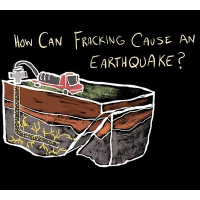Scientists Strongly Link Fracking with Earthquakes in Texas and Oklahoma
 (graphic: World Science Festival)
(graphic: World Science Festival)
Experts in Texas and Oklahoma are more confident than ever that increases in earthquakes are linked to fracking operations.
Seismologists from Southern Methodist University (SMU) and other institutions said in a new study that seismic activity near Azle, Texas, from late 2013 through the spring of 2014 was likely caused by high volumes of wastewater injection along with saltwater extraction from natural gas wells. Sophisticated 3D modeling was used to determine that changes in fluid pressure under the earth were significant enough to set off earthquakes.
“The model shows that a pressure differential develops along one of the faults as a combined result of high fluid injection rates to the west and high water removal rates to the east,” Matthew Hornbach, SMU associate professor of geophysics, said. “When we ran the model over a 10-year period through a wide range of parameters, it predicted pressure changes significant enough to trigger earthquakes on faults that are already stressed.”
Heather DeShon, SMU associate professor of geophysics, said, “We can rule out stress changes induced by local water table changes. While some uncertainties remain, it is unlikely that natural increases to tectonic stresses led to these events.”
Meanwhile, state seismologists in Oklahoma have joined other scientists in acknowledging a link between earthquakes and the underground disposal of billions of barrels of wastewater from oil and gas wells. The state-run Oklahoma Geological Survey (OGS) said it “considers it very likely” that wastewater wells are causing most of the state’s earthquakes.
A new state government website includes evidence linking the rash of earthquakes to thousands of wastewater-injection wells and records the sites of temblors 3.0 or larger.
The admission is quite a turnaround in conservative Oklahoma, where Republican Governor Mary Fallin had consistently refused to blame fracking for seismic activity. As part of the turnaround she released a statement saying: “Oklahoma state agencies already are taking action to address this issue and protect homeowners,” according to The New York Times.
The state’s oil and gas industry has yet to be convinced by the mountain of evidence, however. “There may be a link between earthquakes and disposal wells,” Oklahoma Oil and Gas Association president Chad Warmington said in the statement, “but we — industry, regulators, researchers, lawmakers or state residents — still don’t know enough about how wastewater injection impacts Oklahoma’s underground faults.”
-Noel Brinkerhoff, Steve Straehley
To Learn More:
SMU-Led Seismology Team Reveals Azle Findings (Southern Methodist University)
Causal Factors for Seismicity Near Azle, Texas (by Matthew J. Hornbach, Heather R. DeShon, William L. Ellsworth, Brian W. Stump, Chris Hayward, Cliff Frohlich, Harrison R. Oldham, Jon E. Olson, M. Beatrice Magnani, Casey Brokaw and James H. Luetgert, Nature Communications)
Oklahoma Recognizes Role of Drilling in Earthquakes (by Michael Wines, New York Times)
Earthquakes in Oklahoma (Oklahoma Secretary of Energy and Environment)
Oklahoma Scientists Agreed to Keep Quiet about Fracking-Earthquake Link for 5 Years (by Danny Biederman and Noel Brinkerhoff, AllGov)
Texas and Oklahoma Question whether Fracking Disposal Wells Cause Earthquakes (by Noel Brinkerhoff, AllGov)
- Top Stories
- Unusual News
- Where is the Money Going?
- Controversies
- U.S. and the World
- Appointments and Resignations
- Latest News
- Trump to Stop Deportations If…
- Trump Denounces World Series
- What If China Invaded the United States?
- Donald Trump Has a Mental Health Problem and It Has a Name
- Trump Goes on Renaming Frenzy






Comments